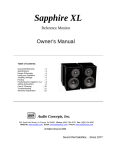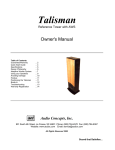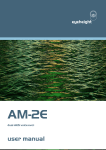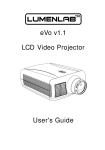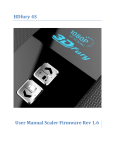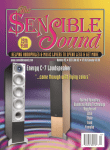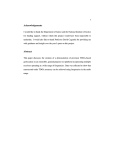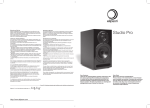Download Protege Manual - Audio Concepts, Inc.
Transcript
Protégé Shielded Reference Owner's Manual Table of Contents: Guarantee/Warranty Specifications Design Philosophy Using your Speakers Avoiding Damage Hookup Positioning the Protégé Break-In Troubleshooting Warranty Registration …2 …4 …4 …6 …6 …7 ...8 …9 …9 …11 Audio Concepts, Inc. 901 South 4th Street, La Crosse, WI 54601 Phone: (608) 784-4570 Fax: (608) 784-6367 Website: www.audioc.com Email: [email protected] All Rights Reserved 2003 Sound that Satisfies… 2 Audio Concepts, Inc. Our Guarantee and Warranty Satisfaction Guaranteed: We’re sure you’re going to love your new Audio Concepts, Inc. (ACI) products! In the unlikely event that you are not satisfied, please contact us within 30 days of receipt of your ACI products for a hassle-free return. Simply follow these procedures: 1. Return Authorization: Call us at (608) 784-4570 or email [email protected] , within 30 days of receipt of your ACI products for a return authorization number. Boldly mark the return authorization number on the outside of the box. Include a brief note stating your name, address and daytime telephone number, along with a short description why the products are being returned. 2. Returning: We request that you return the ACI products to us in their original packaging and include packaging materials, manuals, etc. Ship by the most economical means (preferably UPS) and insure the products for the invoice purchase price. The customer is responsible for return shipping. Please note: ACI can not accept C.O.D. returns. 3. Credit: Upon receipt and inspection, we will issue a refund for the invoice purchase price and invoiced UPS Ground service only. Please note this return policy is in effect only if the ACI products are in new condition, in their original packaging, without drilled holes, disassembled or any other modifications. Speaker Manufacture’s Warranty: ACI’s Five Year Standard Warranty and One Year Total Assurance Guarantee For five years from receipt, Audio Concepts, Inc. will, at its option, repair or replace factory defective components. This warranty excludes products that have been abused, modified, or disassembled in any way. This warranty does not apply to products, which have been damaged in shipping. Audio Concepts, Inc. liability is limited only to the replacement of defective parts. No other liabilities or obligations are expressed or implied. For the first year of ownership, ACI also provides a unique Total Assurance Guarantee, (TAG). TAG from ACI not only covers everything included in our standard five year warranty, but we will also pay for shipping to ACI and back to your front door. TAG is limited to shipping destinations in the Continental U.S. The ACI Five Year Standard Warranty and One Year Total Assurance Guarantee are fully transferable from the original owner to a secondary owner provided that the original owner notifies ACI, by phone call or by filling out the on-line form: www.audioc.com/order/warranty_transfer.htm No warranty will be transferred absent this notification. Simply follow these procedures: 1. Return Authorization: Call us at (608) 784-4570 or email [email protected] for a return authorization number. If the warranty repair is during the first year of ownership, additional instructions will be given to you at that time. Boldly mark the return authorization number on the outside of the box. Include a brief note with your name, address and a daytime telephone number, along with a short description why the products are being returned. 2. Returning: Carefully repack defective ACI merchandise in their original packaging. Ship by the most economical means (preferably UPS) and insure the products for their full retail value. The customer is responsible for return shipping (unless the first year TAG applies). Please note: ACI can not accept COD or Freight Collect returns. 3. Replacement: Audio Concepts, Inc. will inspect and determine the cause of failure and will pay return shipping on the defective goods replaced or repaired. Please ship any returns to the following address: Audio Concepts, Inc., 901 So. 4th Street, La Crosse, WI 54601 (608) 784-4570 3 IMPORTANT NOTICE All new speakers require a minimum of 60 hours break-in-time before they sound the way they are supposed to. A speaker's performance improves significantly once broken in. It is critical that you have at least 60 hours on your speakers before you evaluate them. Don't worry if your speakers do not sound perfect the first time you play them. This is normal until they are broken in. If you are having difficulty getting enough hours on your speakers and your 30 day return privilege is getting near, call us. We will work with you. Please give us the courtesy of breaking the speakers in before you determine they don't sound right. Many of our customers break their speakers in by: A) Leaving them on at moderate listening levels when they are not home. B) Leaving them on at moderate listening levels while they sleep. C) Running pink noise through them. These methods are not convenient for everyone and we understand this. But please know that you are not giving yourself, your speakers or us a fair chance if you do not break them in before critical evaluation. THANK YOU! 4 The Protégé Thank you for your order and congratulations on becoming the owner of an Audio Concepts, Inc. (ACI) speaker system. The Protégé is an audiophile quality system that will provide you with many years of listening pleasure. Be sure and take a moment to register your warranty either by mail or on-line at www.audioc.com. Derived from our acclaimed Essence and Veritas centers, the Protégé has all the qualities you expect from an ACI center. Precise tonal matching with other ACI models. Dynamic capabilities that will handle the most intense soundtracks with ease. Dialog reproduction second to none. ACI build quality and beauty. Only a center with a vertical mid-tweeter alignment with flanking woofers can provide this kind of performance. Only a center with drivers this good need apply for the job. Only a center with ACI designed precision crossovers will fit this bill. And only a center built by ACI will look and sound this good! As in all ACI products, the finest drivers are used with extensively engineered and tested precision crossover networks. The cabinets are built to be extremely inert with extensive internal bracing. The midrange chamber is specially shaped and damped. All design and quality aspects combine to yield absolute state-ofthe-art sound. The use of the finest lacquers and hardwoods results in a cabinet of exceptional beauty and durability. Specifications Frequency response: 75-20kHz ±3db Nominal impedance: 6 ohms Sensitivity: 86db 1 watt/1 meter Bass-loading: Second order sealed system Recommended RMS Power: 50-250 watts Tweeter: 1” silk dome, ferro-fluid cooled, neo magnet, shielded Bass-mid: 4", rubber surround, double magnet, long-throw shielded Woofers: Dual 5 1/4" long-throw, rubber surround, double magnet, shielded Dimensions: 8” H x 20” W (21 ½” with optional hardwood panels) x 11” D Weight: 35 lbs with hardwood panels Recommended accessories: Center Stand, DH Labs Speaker Cable Design philosophy for the Protégé Modern speaker design is a combination of science, art and sweat. A successful design such as the Protégé requires thousands of hours utilizing computer modeling, several generations of prototypes, precision testing, critical listening and many "fine tunings". Our design goals for the Protégé were to produce a smaller, less expensive speaker than the Essence or Veritas that would still serve as a standard for multi-channel use. The Protégé had to be the ultimate performer not only for the center channel, but for all channels in a multi-channel system. The Protégé had to be an attractively proportioned and constructed speaker with smooth, uncolored, wide-range response, threedimensional stereo imaging, good sensitivity, high power handling and dynamics, crystal clear dialog and effects, and the ability to convey the "soul" of the musical score. The Protégé also had to use specially developed shielded drive units to allow placement right next to, on top of, or under a television set or video 5 monitor. The Protégé had to be extremely linear in the midrange with controlled dispersion to provide optimum speech intelligibility for video dialog, (center channel) applications. We also set a goal that the Protégé must be able to achieve optimum performance in their system and room placement. We are pleased to have achieved and in some areas exceeded our goals by systematically engineering the Protégé to optimize performance. Please note the following factors: Frequency Response: For a speaker to be considered "accurate" it must have a smooth frequency response that is free of major dips, peaks, troughs or plateaus. The Protégé exhibits exceptionally flat response; ± 3db from 75Hz to 20Khz and better than ± 1.25db from 100Hz to 10kHz! The long-throw woofers provide exceptional bass performance down to the cutoff frequency. We could have chosen to extend bass response even further, as low as 40-50Hz to excel at the “spec wars”. Instead, we chose the 75Hz cutoff point to insure completely unlimited dynamic range capabilities with any music or soundtrack source material. The normal crossover frequency to the subwoofer in quality multi-channel systems is 80Hz. The Protégé will allow a seamless transition to the high-quality subwoofer(s) of your choice. Of nearly equal importance is the off-axis response of the speaker. This response from 15 to 45 degrees off the axis of the speaker determines the smoothness of the early reflections from the wall surfaces. In video applications the off-axis response characteristics are extremely important for accurate voice and special effects reproduction. In most domestic listening situations this energy is nearly equal to the on-axis response in determining the balance of the system. The off-axis response should show a gradual decrease in output with increased frequency. The Protégé has an exceptionally well controlled and smooth off-axis dispersion pattern. Tight quality control procedures are necessary to assure that your Protégé sound every bit as good as our lab samples. Incoming shipments of raw parts including cabinet materials, drivers and crossover components are subject to extensive testing to verify that they meet our exacting standards. For example, the industry standard for crossover component tolerance is usually 10%, sometimes as high as 20%. ACI’s standard is tighter than .1%! Dynamic range: Dynamic range in a speaker requires; • Adequate sensitivity so that it may be driven to realistic levels with available amplification. The C-weighted sensitivity for the Protégé is 86db. • An easy load for the amplifier. A speaker can have a high sensitivity number but may present a difficult load for the driving amplifier. The impedance curve of the Protégé never drops below 4 ohms and is an easy load for any receiver or amplifier. • Low distortion drive units are necessary to keep the music from becoming edgy or gritty as the volume is turned up. The drive units used in the Protégé have very linear suspensions to reduce distortion components to inaudible levels and contribute to the excellent sense of "clarity". The crossover used keeps low frequencies out of the tweeter and protects it from over-excursion at resonance, which would otherwise cause increased distortion. The high-quality, shielded silk-dome tweeter by Vifa of Denmark provides excellent damping, smooth crossover transition, and excellent power handling. The midrange driver actually can be used full range with good results. With the 300Hz crossover this mid-range is freed of bass duties and has unlimited dynamic range. Delayed Resonance Control: The ultimate control of delayed resonance required extensive use of Cumulative Spectral Decay analysis coupled with accelerometer testing of the cabinet wall surfaces. This extensive testing allowed us to develop the most cost-effective internal bracing to create the vault like solidity of the Protégé . The midrange driver has its own separate inner chamber that is used as a part of the cabinet bracing scheme. The entire cabinet is formed of an incredibly inert and well-damped medium density fiberboard (MDF) specified at 49.3 pounds per cubic foot density, with solid hardwood panels added over the MDF cabinet. Pick up a Protégé and notice how much it weighs. Both drive units were designed with effective resonance control in mind. 6 We've attempted to show you some of the important design considerations that go into the Protégé system. To fully document the design process would require many hundreds of pages. We haven't even discussed the extremely high level of quality control that must be exercised in the drivers, crossovers and enclosure to maintain the design standards. But the most important point is that the Protégé was designed by and for music lovers. You must hear the Protégé system reproduce your favorite music and or video soundtracks over a period of time to appreciate how fine these speakers are. Using your speakers There are several factors in setup that you should consider first. • The Protégé connects to your system just like any other speaker. Gold-plated binding posts are mounted on the back for connection to your receiver or amplifier. • If you elect to use the Protégé on top of a direct - view or RPTV you may need to create some sort of shelf to support the rear of the speaker as it may be deeper than the top of your screen. You may wish to use some sort of rubber or similar padding between the Protégé and any shelf it is resting on. • If installing the Protégé in a custom enclosure or cabinet allow at least 1-2" behind the speaker for wiring hookup. If the rest of your system does not work properly or is not correctly connected you will not get the best performance from your system. To eliminate problems we recommend the following: 1. Use the finest associated components you can afford. Turntables, cartridges, pre-amps, amplifiers (receivers), CD players, DVD players, SACD players and cables all have profound impact on the sound of your system. Accurate speakers let more detail through. You will hear more of the beauty of the music, but flaws in your system and or source material may be more obvious. Any good audio system is made up of matched components. You wouldn’t use bargain recap tires on a new Porsche, and you shouldn’t use inferior components with a high quality speaker. Your Protégé performs like speakers costing two to four times their price. Keep this in mind when selecting the rest of your system. Your Protégé will work in systems with as little as 50 watts per channel. High-quality amplification of 100 - 200 watts or even more per channel may be used. 2. Know your source material. People often blame their audio gear for poor recordings. A great number of popular recordings are of inferior sound quality. Unfortunately this applies to records, tapes, laser discs, DVDs and CDs. Commonly poor recordings are rolled off in the low bass, and harsh and constricted in the mids and highs. Good stereo image is rare. Many recordings are still done on old studio monitor speakers that are grossly inaccurate. Consider that some producers still mix recordings to sound best on cheap table and car radios! This doesn’t mean you can’t enjoy these recordings, but you should try a few of the best audiophile recordings just to see how terrific your system can be when fed a good signal. 3. Work at getting the best placement of your speakers in their environment. It is not unusual to be able to get a 25 to 50 percent improvement in sound by careful placement of speakers and furniture. It may not be practical to go all out, but the more you can “tune” your room, the better your system will sound. Refer to the section on placement and room treatment. Avoiding Damage Audio Concepts, Inc. speakers are designed for the purpose of accurate reproduction of music in the home. We do our best to make our speakers rugged and reliable. However, ANY speaker or system may be damaged under certain conditions: 7 • • • • Excessive power, particularly at certain frequencies or for prolonged periods of time. Excessive distortion often caused by under-powered amplifiers or receivers. Defective amplification. Excessive subsonic energy. Our systems are tested at high volume levels with a variety of amplifiers and receivers before a design is approved. With many years of testing, we know it is virtually impossible to damage a component without the system first giving audible warning in the form of distortion. We also know that true factory defects are extremely rare, less than one in 10,000 drivers. Here are some considerations to keep in mind to avoid damaging your drivers: 1. 2. 3. Even though a system may be rated for 100 watts or more it is very easy to damage it with a low power receiver. When an amplifier runs out of power, it “clips”. This clipping produces large amounts of distortion that sends excessive energy particularly to the midrange and tweeter. This clipping distortion accounts for more than 80% of all tweeter failures. How do you know if the amplifier is clipping? Volume knob placement does NOT indicate much. Some receivers reach full output well before 12:00 on the dial. Use of the loudness button, bass boost and treble boost can all drive the receiver and then the speaker into distortion at fairly low levels. Many of today’s recordings including CDs and DVDs contain extremely powerful low bass. This low bass can easily drive woofers into over-excursion or cause the amplifier to run out of power and clip, causing tweeter or midrange damage. Our systems are designed for accurate sound. Our rate of damage or failure is extremely low. We could make the systems even more rugged if we were to compromise sound quality. Moving the crossover points upward would protect midrange and tweeters better while causing a loss of detail, clarity and imaging. The Protégé could have been designed to more rapidly roll-off the low bass which would protect the woofers but this would lessen the low bass response and clarity. Protection devices could be added in the crossovers, which would shut the system down when damaging power or distortion was present but every one of these devices audibly degrades the sound! You can protect your speakers by following a couple of very simple guidelines: • • • • • • • If it sounds at all distorted, turn it down. Distortion is a warning sign that should not be ignored. Use tone controls with caution. IF you must use equalizers, monitor the system carefully. Beware the party damage epidemic. Speakers are more often damaged during parties. All those bodies soak up sound, requiring more output to sound as loud, bass and treble controls are sometimes cranked up and nobody is listening for distortion! Watch out for energy put out by the amplifier in the range below 20Hz, which is not music. Examples include record warps, DC current and subsonic noise in the recording. These signals can take up a lot of amplifier power which means the amplifier runs out of steam very early. These signals can also overload a speaker even though you can’t hear them. If you have ever watched a cone “flap” you know just what we mean. Vented speakers are particularly sensitive to signals below their F3 point. The average vented box that can handle 100 watts at 50Hz may handle less than 5-10 watts below 25Hz! Sealed box speakers with low Qts. numbers have a similar characteristic although not as severe. Low organ or synthesizer notes may cause an otherwise excellent woofer to bottom out at relatively low input levels. Keep an eye out for excessive cone movement that is not producing music. Find the source of the problem and eliminate it, play at low levels, or use a subsonic filter (usually in your pre-amp) which will filter out energy below 20Hz. However, use of a subsonic filter may take away from the naturalness of bass sounds. We don’t recommend it for extremely critical listening. In over twenty-five years of daily evaluation of all types of speakers on everything from 10 to 1000 watts and with all kinds of music, we have never damaged a driver without first hearing audible distortion. If it sounds bad, turn it down and you will never damage a speaker. Hookup Your speakers are furnished with high quality five-way type binding posts. You may choose to utilize spade lugs, banana jacks, pins, or bare wire. It is important that the positive and negative leads do not touch. If you use bare leads, be sure to twist them tightly and insert through holes in such a manner that they do not 8 fray or short out against each other. Good connections are important, so make sure any ends are tightly crimped and preferably soldered to the wire ends. Speaker wires should be kept as short as possible, (long wires add excessive resistance and color the sound.) The use of quality wire is recommended. Audio Concepts, Inc. stocks and recommends DH-Labs cables. Make sure you hookup the speakers in the correct polarity. The red (positive) terminal on your amp should hook up to the red binding post, and the black (negative) terminal should be connected to the black binding post. Keep this the same for both speakers in a stereo pair, and all three front speakers in a home-theater setup. A way to check the correct polarity is to play music with a lot of bass. The correct hookup will yield the greatest amount of bass. Positioning your Protégé • • Optimum placement is with the tweeter close to ear level. If the speaker will be significantly above or below ear level we recommend tilting the speaker up or down to aim at the primary listening position. Placing the speakers in your room As mentioned, the proper placement of speakers in your room will easily improve the sound. Because all of our rooms and tastes are different, it is impossible to specify a “correct” placement. Instead, let us present you with some acoustical facts, then you can optimize placement in your room. It helps to visualize sound waves as behaving very much like water waves. The sound we hear is made up of two types of waves. Direct sound waves come right from the speaker and are not changed in any way. Reflected waves come to us after bouncing (diffracting) off the speaker enclosure itself, or walls, ceiling, floor or furniture. If you want to see how much these reflected waves affect the sound, move your speakers outside and hear the difference. Sound waves come in different lengths; the lower the note, the longer the wave. Extreme low frequencies such as the lowest organ pedal notes are over 60 feet long! If your room is not big enough, the wave can’t develop fully. But the biggest problem with bass notes is the phenomenon we call standing waves. In effect the waves more or less “pile up”. This creates big peaks and dips in the bass response. If you put a certain frequency through the speakers, you can usually walk around the room and find places where it is very loud, and places where you perceive virtually nothing. Just as the room affects the bass response, so it affects the mid-treble sound of the system. In the mid-treble range, the sound waves are shorter and have peaks and dips, most of the affects (peaks and dips) occur from enclosure edges, furniture, walls, or the floor. The Protégé will exhibit the deepest image when placed away from walls and furniture. Of course this is often not possible when used as center or front speakers in a multichannel system. The shorter wavelengths of the mids and highs are more easily absorbed than the longer wavelengths of low frequencies. This is why a bare room sounds so harsh compared to a room with a lot of stuffed furniture, carpets, drapes, etc. An ideal setup for sound would be achieved if you could: • Choose a room with width, height and length dimensions that are not multiples of each other. (A cube would be the worst!) Good numbers might be something like, height = 8 feet, width = 15 feet, and length = 26 feet. • Choose a room that has an irregular shape, non-parallel walls cut down on standing waves. • Use absorbent materials to help smooth upper-range response and improve transient response and clarity. Why? Let’s take the sound of a bell for example. First you will hear the direct sound from the speaker. But some of that sound bounces from wall-to-wall, ceiling-to-floor, off furniture, etc. before it reaches your ears milliseconds later. Because the time difference is short, you don’t hear an echo, but the sound of the bell is stretched out from something like a “ding” to a “ddiiinngg”. Some speaker engineers have begun to realize this and are addressing the problem in their latest designs. This is why we are now seeing very directional designs. This controlled directionality increases the amount of direct sound in proportion to reflected sound. 9 • Keep the mids and tweeters away from the floor if possible. Often, the Protégé may have to be placed below a screen. If this is the case, try to place the speaker at least 12" off the floor and tilt it up toward the listening position. • The Protégé may be flush mounted in a cabinet under the screen, mounted behind a perforated screen or flush mounted above a screen. If the placement is significantly above or below the screen we recommend tilting the speaker up or down toward the listening position. The Protégé may also be stand mounted on a short stand in front of the screen. Mount the left and right speakers as close to the same horizontal plane as the Protégé. • Use padded furniture and drapery when possible to cut down on reflections. Furniture has the added bonus of helping to break up standing wave patterns in the bass. Speaker Break-in ****Important!!! Allow at least 60 to 80 hours of playing time before your new ACI speakers will sound their best. The adhesives and materials used in manufacturing must stretch and flex properly before a speaker will sound its best. After break-in the bass will be tighter and go lower, imaging and transparency will improve and the midrange and highs will sound smoother and more natural. Suggestions for quicker break-in: • • • Play the Protégé at medium volume while away from home. A CD player on repeat or FM radio works fine. Leave it on at moderate listening level while sleeping. Run pink noise through it. Troubleshooting Occasionally we get a call from someone who feels there is a problem with his or her ACI speaker. At least a couple of times a year we will get a call or email that goes something like this: “Speaker not working properly, can’t get enough sound even with the volume turned way up.” The problem may be different, but with this little information to go on it is almost impossible to trouble shoot the problem “long distance”. The following checklist may help: 1) Are all system hookups properly connected, not partial shorted wires, or reversed connections, etc? 2) Did you try the rest of your system with other speakers to determine if the problem exists with the speakers? 3) Please be realistic in your expectations. Our speakers offer excellent value but we can’t beat the laws of physics. Our speakers are designed for high-end home audio and home-theater systems, not stage sound-reinforcement. 4) IF for any reason you aren’t satisfied with the sound you’re getting from your speakers we want to know about it. Make sure the speakers have had adequate break-in time. Before you call, write or email please try to narrow down the problem and eliminate other factors. If you contact us we will need to know: • The size of your room • Where you have the speakers placed • What other equipment is in your system • Have you tried other speakers (which ones, and did they eliminate the problem) • Any other specific symptoms or information you can provide Our Customers are #1 with us, and we want you to be completely happy with your ACI speakers! 10 The Company Audio Concepts, Inc. (ACI), has been satisfying discerning music lovers since 1977. Our goal has and always will be to provide exceptional product and service to music enthusiasts around the world. Audio Concepts speakers are an expression of dedication to our customers and their desire for accurate musical reproduction. We believe you must audition speakers in your own home and in your own system. Please see the warranty statement for details. After listening, please fill out and return the warranty registration. This warranty registration is important. It allows us to reach you in the event of future upgrades. The comments you make on the warranty help us to continually improve our products and customer service. Thank you! Specifications and design are subject to change without notice due to our continuous research and development program. Handcrafted with pride in the U.S.A. Audio Concepts, Inc. th 901 South 4 Street La Crosse, WI 54601 Phone: (608) 784-4570 Fax: (608) 784-6367 E-Mail: [email protected] URL: http://www.audioc.com All rights reserved Audio Concepts, Inc. 2003 Rev 12/03 11 Warranty Registration, Please Return ACI div. Audio Concepts, Inc. 901 S. 4th Street, La Crosse, WI 54601 [email protected] (608) 784-4570 Congratulations on becoming an ACI speaker owner. Completing this registration enables us to contact you regarding future upgrades. Your information helps us provide the best possible products and service. If you need additional room please continue on the back. You may also register your product electronically at our web site. http://www.audioc.com Name: ___________________________________________________________________________________ Address: _________________________________________________________________________________ Main reasons you purchased from ACI: _________________________________________________________ Where did you first hear about ACI: ___________________________________________________________ System(s) purchased: _______________________________________________________________________ Date received: _____________________________ Invoice Number: _________________________________ Condition received in: ______________________________________________________________________ Comments or suggestions regarding our staff or service: ___________________________________________ Other audio equipment used: _________________________________________________________________ Do you have a home-theater system? ___________________________________________________________ Do you plan to purchase other speakers within the next two years? _____ If so, what types of speakers are you interested in purchasing, (Tower speakers, satellite speakers, subwoofers, wall speakers, outdoor speakers, home-theater speakers, etc.) __________________________________________________________________ _________________________________________________________________________________________ All speakers require at least 60-80 hours of playing time to sound their best. After your speakers have had time to break-in and you've done some serious listening please tell us: Features you like most about your ACI speakers: _________________________________________________ _________________________________________________________________________________________ _________________________________________________________________________________________ Areas of performance or appearance you'd like to change: __________________________________________ _________________________________________________________________________________________ Other comments or suggestions: ______________________________________________________________ Will you recommend us to others? ________ (Over 1/2 of our customers were recommended to us by testimonials on computer data bases or referrals from someone they know. We put the money we save on advertising into the highest quality products at the lowest possible cost to you.) We would appreciate being able to use your comments in future advertising. Please sign here to allow us that privilege. Name: _________________________________________ Date: ___________________ Thank you for taking the time to complete and return this registration!











